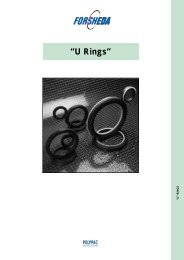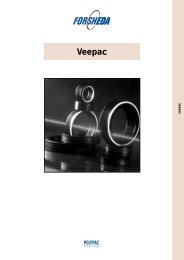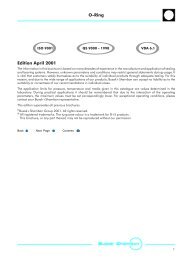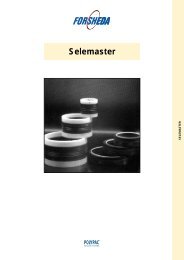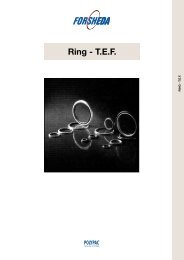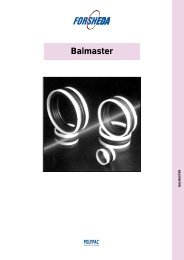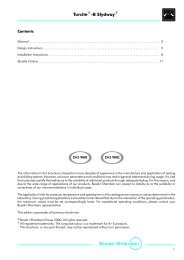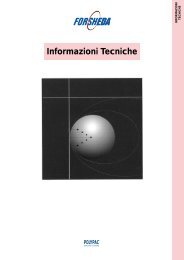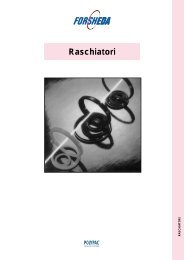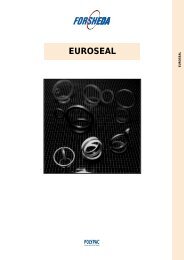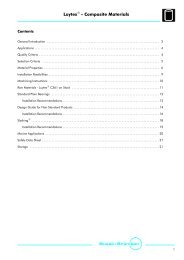Rotary Seals - Dilanda.it
Rotary Seals - Dilanda.it
Rotary Seals - Dilanda.it
Create successful ePaper yourself
Turn your PDF publications into a flip-book with our unique Google optimized e-Paper software.
V—Ring<br />
70<br />
65<br />
60<br />
d=190<br />
V-Rings in low friction n<strong>it</strong>rile (N6T5C)<br />
V-Rings for general use (N6T50)<br />
d = shaft diameter (mm)<br />
55<br />
Power loss (W)<br />
50<br />
45<br />
40<br />
35<br />
30<br />
25<br />
20<br />
15<br />
10<br />
5<br />
0<br />
d=150<br />
d=120<br />
d=75<br />
d=50<br />
d=25<br />
d=190<br />
d=150<br />
d=120<br />
d=75<br />
d=50<br />
d=25<br />
Technical Data:<br />
- Dry running<br />
- Mating surface steel,<br />
unhardened<br />
Nb.<br />
Since this graph is based on a specific<br />
test, the values should only be<br />
regarded as indicative !<br />
0 2 4 6 8 10 12 14 16 18<br />
Peripheral speed (m/s)<br />
Figure 54<br />
Power loss as a function of peripheral speed for various sizes<br />
n Materials<br />
When selecting the correct rubber compound <strong>it</strong> is necessary<br />
to take the following requirements into account;<br />
- good chemical resistance<br />
- good resistance to high and low temperatures<br />
- good resistance to ozone and weathering<br />
It is also necessary to consider the need for the following<br />
attributes;<br />
- high resistance to wear<br />
- low friction<br />
- low compression set<br />
- good elastic<strong>it</strong>y<br />
Material types<br />
The most frequently selected material is the purpose made<br />
N<strong>it</strong>rile rubber N6T50 which has excellent allround<br />
properties.<br />
For applications w<strong>it</strong>h temperatures above 100°C, or in<br />
chemically aggressive cond<strong>it</strong>ions, V—Rings made of<br />
fluorinated rubber (FKM) can be supplied. In fact a wide<br />
range of rubber compounds is available and some of these<br />
are listed below.<br />
Table XXXIX<br />
B+S<br />
code<br />
Old<br />
(FORSHEDA)<br />
code<br />
Guide to selection of rubber material<br />
Type of<br />
rubber<br />
Characteristics<br />
N6T50 NBR 510 N<strong>it</strong>rile For general use<br />
N7T50 NBR 555 N<strong>it</strong>rile Heavy duty cond<strong>it</strong>ions.<br />
Good tear and<br />
abrasion resistance<br />
N6T5C NBR 562 N<strong>it</strong>rile Low friction<br />
H7T50 HNBR 576 Hydrogenated<br />
N<strong>it</strong>rile<br />
Hypoid oils at high<br />
temp.<br />
CDT50 CR 415 Chloroprene For applications in the<br />
presence of ozone<br />
E7T50 EPDM 762 Ethylene-<br />
Propylene<br />
Good weather and<br />
ozone resistance, used<br />
w<strong>it</strong>h special chemicals<br />
such as acetone,<br />
ammonium carbonate<br />
and benzaldehyde<br />
VDT50 FKM 900 Fluorinated Very high temperature<br />
and chemical resistance<br />
Latest information available at www.busakshamban.com<br />
Ed<strong>it</strong>ion April 2006<br />
145



